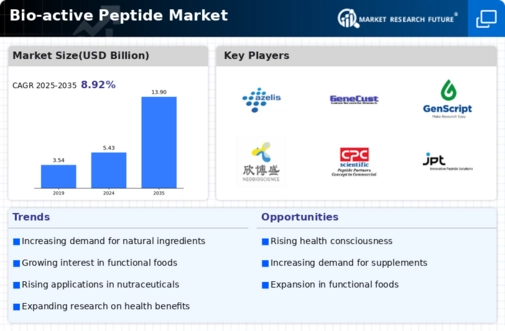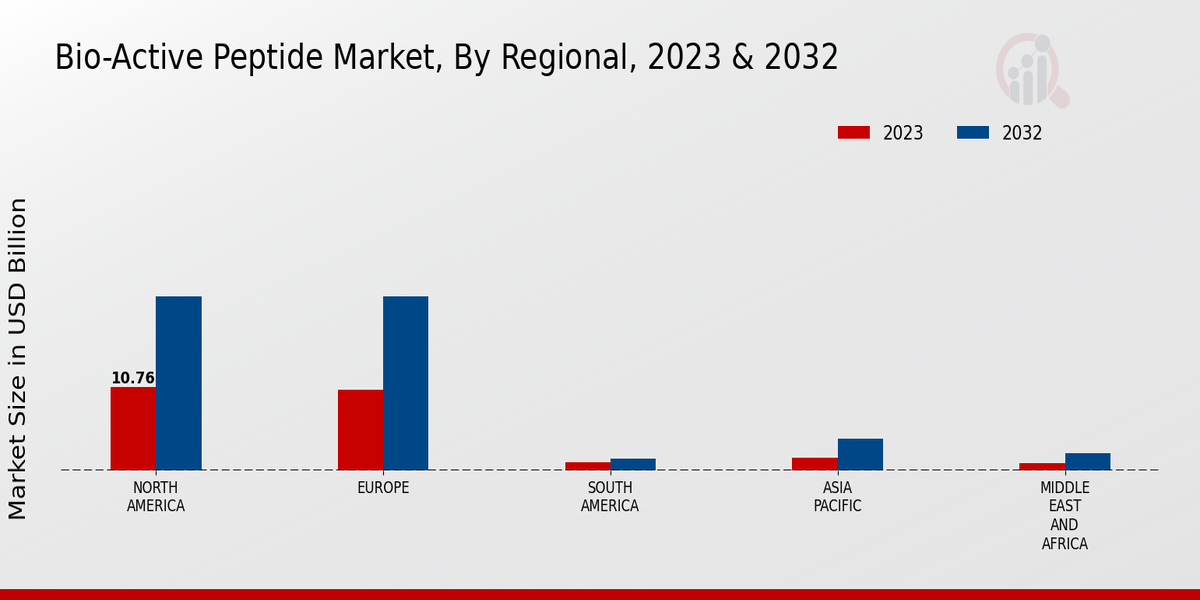Market Growth Projections
The Global Bio-active Peptide Market Industry is poised for substantial growth, with projections indicating a market value of 5.43 USD Billion in 2024 and an anticipated increase to 13.9 USD Billion by 2035. This growth trajectory reflects a compound annual growth rate (CAGR) of 8.91% from 2025 to 2035, highlighting the increasing adoption of bio-active peptides across various sectors. The expanding applications in nutraceuticals, pharmaceuticals, and functional foods contribute to this upward trend, suggesting a robust future for the industry. These figures underscore the potential of bio-active peptides to transform health and wellness markets globally.
Advancements in Biotechnology
Technological advancements in biotechnology significantly influence the Global Bio-active Peptide Market Industry. Innovations in peptide synthesis and purification techniques enhance the efficiency and yield of bio-active peptides, making them more accessible for various applications. These advancements not only improve product quality but also reduce production costs, thereby expanding the market reach. As the industry embraces these technologies, the market is expected to grow substantially, with projections indicating a rise to 13.9 USD Billion by 2035. This growth underscores the potential of biotechnology to revolutionize the bio-active peptide sector, fostering new opportunities for manufacturers and consumers alike.
Consumer Awareness and Education
Consumer awareness regarding the health benefits of bio-active peptides is a crucial driver for the Global Bio-active Peptide Market Industry. As educational initiatives proliferate, consumers are becoming more informed about the nutritional advantages of bio-active peptides, leading to increased demand for products containing these compounds. This heightened awareness encourages manufacturers to innovate and diversify their offerings, catering to the evolving preferences of health-conscious consumers. The market's growth trajectory is likely to be influenced by this trend, as consumers actively seek products that align with their health goals, further solidifying the role of bio-active peptides in the food and supplement sectors.
Regulatory Support and Standards
Regulatory support plays a vital role in shaping the Global Bio-active Peptide Market Industry. Governments and regulatory bodies are increasingly recognizing the potential health benefits of bio-active peptides, leading to the establishment of guidelines and standards for their use in food and supplements. This regulatory framework not only enhances consumer safety but also fosters innovation within the industry. As regulations become more favorable, manufacturers are encouraged to invest in research and development, potentially leading to a broader range of bio-active peptide products. This supportive environment may contribute to the anticipated growth of the market, aligning with the overall positive outlook for the industry.
Rising Demand for Nutraceuticals
The Global Bio-active Peptide Market Industry experiences a notable surge in demand for nutraceuticals, driven by an increasing consumer focus on health and wellness. As individuals become more health-conscious, the incorporation of bio-active peptides in dietary supplements and functional foods is gaining traction. This trend is reflected in the projected market value of 5.43 USD Billion in 2024, indicating a robust interest in products that promote health benefits. The growing awareness of preventive healthcare further propels this demand, suggesting that bio-active peptides will play a pivotal role in the nutraceutical sector, enhancing the overall market landscape.
Increasing Applications in Pharmaceuticals
The Global Bio-active Peptide Market Industry is witnessing a growing integration of bio-active peptides in pharmaceuticals, particularly in drug development and therapeutic applications. Bio-active peptides exhibit various biological activities, including antimicrobial, anti-inflammatory, and antioxidant properties, making them valuable in treating chronic diseases. The increasing prevalence of lifestyle-related ailments further drives this trend, as pharmaceutical companies seek innovative solutions. This shift towards bio-active peptides in drug formulations may contribute to the market's expansion, aligning with the anticipated CAGR of 8.91% from 2025 to 2035, indicating a promising future for bio-active peptides in the pharmaceutical landscape.














